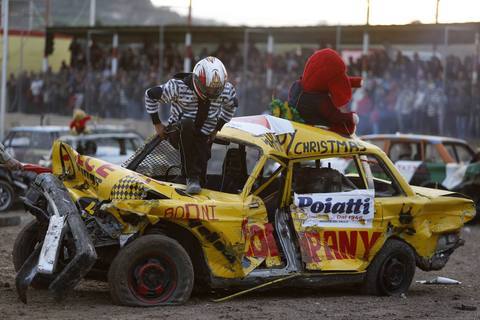Demolition Derbies and The Divine
I love family traditions. Some of our traditions include, attending Ringling Bros. Barnum and Bailey Circus, watching fireworks on the 4th of July and going to our family cabin each summer. However, one tradition stands out as our favorite is, “The Buck Demolition Derby”. Each year, around the 4th of July weekend, a local motor sports venue named “The Buck” holds a crazy out of this world demolition derby located smack dab in the middle of Amish country. To say this event is a melting pot of cultures would be an understatement. It’s kind of like, 21st century white collar suburbanite meets 19th century Amish agricultural person over cars smashing. In our first trip to “The Buck”, we began noticing some interesting patterns. First, the demolition derby was the hang out for young Amish teens to pick up another from the opposite sex. Very interesting! Second, though Amish are not allowed to drive cars for normal usage on the roads, somehow they were allowed to drive for the purpose of smashing into one another (Demolition Derby). Third, and most bizarre, was the young Amish teenagers who had confiscated cell phones. Not technically allowed by the Amish community, these young people would hang out under the grandstands trying to conceal there talking on the phone.

This past week while reading New Media by Lisa Gitelman and Geoffrey B. Pingree I was struck by the authors unpacking of competing meanings of the telephone in Amish Country. More specifically I was intrigued by how Amish individuals or clans would interpret the telephone as a sinful network or a divine service. While reading the following three insights emerged.
Three Key Insights
The position of a phone… Most Amish families in 2014 have telephones. Yet, the century old tension between a sinful network and a divine service is still evident. Though these families have phones, they typically have them installed in the barn, rather than their homes. From this position, Amish who typically rely on farming as the family business use simplistic capitalistic terms to justify the divine. A phone hooked to the house, would be considered… “Devil Wires”, but a phone run to the barn is just good business.
Divine service… Technologies of our present day are allowing us to experience God like attributes. What I mean by this statement is, technology frees us in some ways from our limited capacities. The light bulb freed us from only seeing in the day. The airplane freed us from being geographically bound. The internet freed us from only learning through what was assessable to us. Now all is assessable. Facebook delivered us from only knowing about a few things going on in a couple friends’ lives at the same time. Each of these technologies is allowing us to experience God like characteristics. Some we can handle and others at times we may not.
Facebook and beyond… If it hasn’t been said yet, please let me say it. Something will replace Facebook shortly. It will be profound, more integrated and problem unnerving for some. Yet, when this new medium comes onto the market, will we react with extremism? Either an extremism which says, “It’s the devil” or simply adopt the medium as the “new divine”? Too often we simply adopt blindly, making the new medium what we worship.
An Amish Phone Booth Located by The Barn…

As I read the pages of New Media by Gitelman and Pingree, my heart craves a new understanding of formation in the digital age. One that understands culture, embraces technology, and operates from a deep sustainable position of formation. This position would allow the modern day leader to be deeply formed, using the “divine service” for relationship and influence, while at the same time not being consumed by the unlimited effects of this God like attribute. How have you been using new technologies? Is it in your house, the barn or better yet under the grand stand?
Leave a Reply
You must be logged in to post a comment.